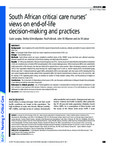South African critical care nurses' views on end‐of‐life decision‐making and practices
| dc.contributor.author | Langley, G | |
| dc.contributor.author | Schmollgruber, S | |
| dc.contributor.author | Fulbrook, P | |
| dc.contributor.author | Albarran, JW | |
| dc.contributor.author | Latour, Jos M | |
| dc.date.accessioned | 2018-02-27T10:12:11Z | |
| dc.date.available | 2018-02-27T10:12:11Z | |
| dc.date.issued | 2014-01 | |
| dc.identifier.issn | 1362-1017 | |
| dc.identifier.issn | 1478-5153 | |
| dc.identifier.uri | http://hdl.handle.net/10026.1/10873 | |
| dc.description.abstract |
<jats:title>ABSTRACT</jats:title><jats:sec><jats:title>Background</jats:title><jats:p>Care of patients at the end‐of‐life (<jats:styled-content style="fixed-case">EOL</jats:styled-content>) may be influenced by the experiences, attitudes and beliefs of nurses involved in their direct care.</jats:p></jats:sec><jats:sec><jats:title>Aim</jats:title><jats:p>To investigate South African critical care nurses' experiences and perceptions of <jats:styled-content style="fixed-case">EOL</jats:styled-content> care.</jats:p></jats:sec><jats:sec><jats:title>Design</jats:title><jats:p>Cross‐sectional survey.</jats:p></jats:sec><jats:sec><jats:title>Methods</jats:title><jats:p>South African critical care nurses completed a modified version of the ‘<jats:styled-content style="fixed-case">VENICE</jats:styled-content>’ survey tool. Data were collected concerning: attitudes towards <jats:styled-content style="fixed-case">EOL</jats:styled-content> care; involvement in <jats:styled-content style="fixed-case">EOL</jats:styled-content> decision‐making; and beliefs about <jats:styled-content style="fixed-case">EOL</jats:styled-content> practices.</jats:p></jats:sec><jats:sec><jats:title>Results</jats:title><jats:p>Of 149 surveys distributed, 100 were returned (response rate 67%). Seventy‐six percent stated that they had had direct involvement in <jats:styled-content style="fixed-case">EOL</jats:styled-content> care of patients, but a minority (29%) had participated in <jats:styled-content style="fixed-case">EOL</jats:styled-content> decision‐making processes. Whilst most nurses (86%) were committed to family involvement in <jats:styled-content style="fixed-case">EOL</jats:styled-content> decisions, less than two thirds (62%) reported this as routine practice. When withdrawing treatment, around half (54%) of the respondents indicated they would decrease the inspired oxygen level to room air, and the majority (84%) recommended giving effective pain relief. Continued nutritional support (84%) and hydration (85%) were advocated, with most nurses (62%) indicating that they were against keeping patients deeply sedated. Most respondents (68%) felt patients should remain in intensive care at the end of life, with the majority (72%) supporting open‐visiting, no restriction on number of family members visiting (70%), and the practising of religious or traditional cultural <jats:styled-content style="fixed-case">EOL</jats:styled-content> rituals (93%).</jats:p></jats:sec><jats:sec><jats:title>Conclusions</jats:title><jats:p>The involvement of Johannesburg critical nurses in <jats:styled-content style="fixed-case">EOL</jats:styled-content> care discussions and decisions is infrequent despite their participation in care delivery and definite views about the process.</jats:p></jats:sec><jats:sec><jats:title>Relevance to clinical practice</jats:title><jats:p>Use of formal guidelines and education is recommended to increase the nurses' involvement in and their confidence in participating in <jats:styled-content style="fixed-case">EOL</jats:styled-content> decisions. Educators, managers, senior nurses and other members of the multi‐disciplinary team should collaborate to enable critical care nurses to become more involved in <jats:styled-content style="fixed-case">EOL</jats:styled-content> care.</jats:p></jats:sec> | |
| dc.format.extent | 9-17 | |
| dc.format.medium | Print-Electronic | |
| dc.language | en | |
| dc.language.iso | eng | |
| dc.publisher | Wiley | |
| dc.subject | End-of-life | |
| dc.subject | Intensive care | |
| dc.subject | South Africa | |
| dc.title | South African critical care nurses' views on end‐of‐life decision‐making and practices | |
| dc.type | journal-article | |
| dc.type | Journal Article | |
| dc.type | Multicenter Study | |
| plymouth.author-url | https://www.webofscience.com/api/gateway?GWVersion=2&SrcApp=PARTNER_APP&SrcAuth=LinksAMR&KeyUT=WOS:000329505000003&DestLinkType=FullRecord&DestApp=ALL_WOS&UsrCustomerID=11bb513d99f797142bcfeffcc58ea008 | |
| plymouth.issue | 1 | |
| plymouth.volume | 19 | |
| plymouth.publication-status | Published | |
| plymouth.journal | Nursing in Critical Care | |
| dc.identifier.doi | 10.1111/nicc.12026 | |
| plymouth.organisational-group | /Plymouth | |
| plymouth.organisational-group | /Plymouth/Faculty of Health | |
| plymouth.organisational-group | /Plymouth/Faculty of Health/School of Nursing and Midwifery | |
| plymouth.organisational-group | /Plymouth/REF 2021 Researchers by UoA | |
| plymouth.organisational-group | /Plymouth/REF 2021 Researchers by UoA/UoA03 Allied Health Professions, Dentistry, Nursing and Pharmacy | |
| plymouth.organisational-group | /Plymouth/Research Groups | |
| plymouth.organisational-group | /Plymouth/Research Groups/Institute of Health and Community | |
| plymouth.organisational-group | /Plymouth/Research Groups/Plymouth Institute of Health and Care Research (PIHR) | |
| plymouth.organisational-group | /Plymouth/Users by role | |
| plymouth.organisational-group | /Plymouth/Users by role/Academics | |
| dc.publisher.place | England | |
| dcterms.dateAccepted | 2013-04-04 | |
| dc.identifier.eissn | 1478-5153 | |
| dc.rights.embargoperiod | Not known | |
| rioxxterms.versionofrecord | 10.1111/nicc.12026 | |
| rioxxterms.licenseref.uri | http://www.rioxx.net/licenses/all-rights-reserved | |
| rioxxterms.licenseref.startdate | 2014-01 | |
| rioxxterms.type | Journal Article/Review |


